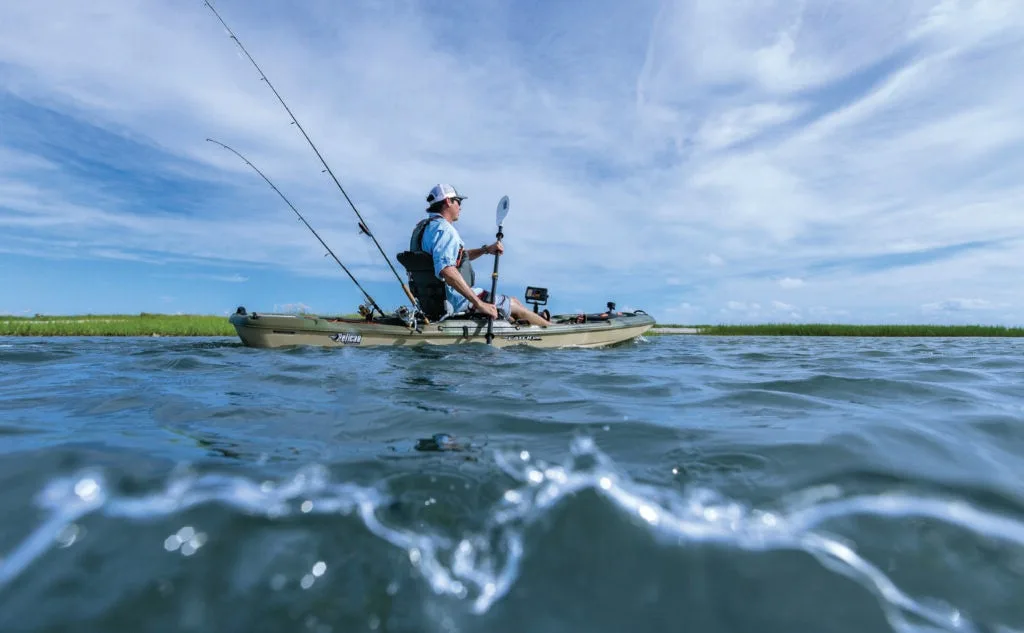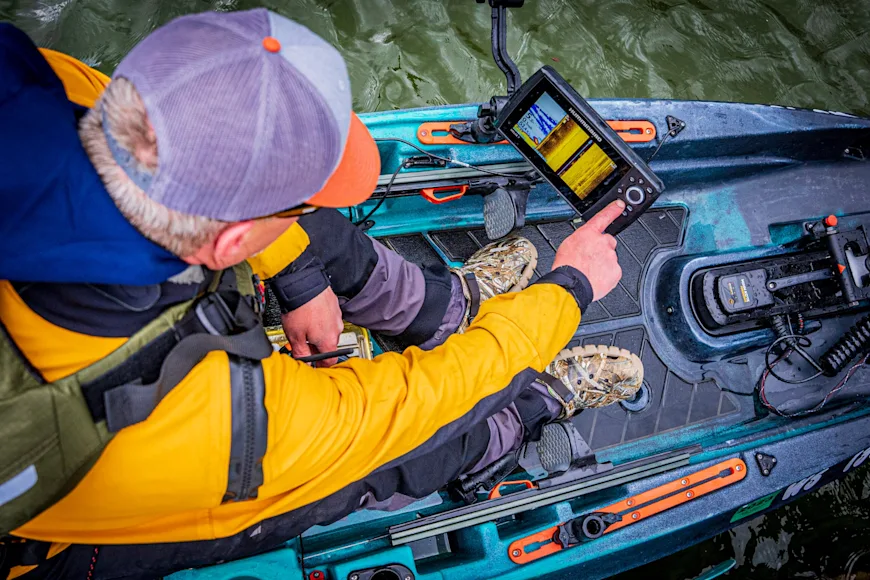_We may earn revenue from the products available on this page and participate in affiliate programs. Learn more ›
_
Before you can catch a fish, you have to find it! The first accessory most anglers add to their fishing kayak is a fish finder
. At the very least, a simple sonar displays water depth. At the other end of the spectrum, a kayak with good electronics will provide a wealth of fishing and navigation information.
The design of fishing kayaks today makes installing electronics easy. Mounting pads, sonar pods, transducer pockets, and more allow the angler to add electronics in minutes. Even boats that aren’t set up for a fish finder can be rigged with electronics. Aftermarket mounts, gear tracks, and battery boxes will turn any kayak into a fishing kayak.
The most difficult step in adding a fish finder to a kayak is choosing the right one. Since no manufacturer makes a kayak-specific fish finder, you’ll be looking at the same units intended for a motorboat. And, just like a motorboat, a fish finder and GPS are valuable for fishing and safety. A fish finder and GPS are critical equipment for any kayak angler who plans to venture farther than he can walk back.

Find structure, drop-offs, and the right depth with a reliable fish finder. Courtesy Garmin
What is the best size fish finder for a kayak?
Some people think a kayak requires a small fish finder, but this is not the case. In fact, many professional tournament anglers use multiple nine-inch screens on their bass kayaks. The best way to choose the right size fish finder is by evaluating your needs.
Many kayak anglers choose a four-inch fish finder to fit in a tight space and draw less power. But, just because the display is small doesn’t mean the fish finder is weak. The best four-inch models feature high-power downscan sonar for the clearest view of fish and structure. There are even compact fish finders with GPS
and detailed navigation maps. Not only is a four-inch sonar easier to fit in a kayak, but it is also easier to remove and store. Many small units have a quick release for the display to help it easily detach from the base.
The problem with a four-inch screen is viewing the display. The best place to install a fish finder is out of the way. That means mounting the base where it won’t interfere with paddling, pedaling, or fishing. Unfortunately, mounting a small fish finder outside arm’s reach makes it difficult to see the information and images.
For the best visibility, kayak anglers choose a five or seven-inch display. However, if you plan to use the unit in split-screen mode to see both fish finder and GPS simultaneously, I recommend the seven-inch display. The seven-inch screen is easy to see, and the larger buttons allow me to manipulate the features with wet and slimy fingers. Larger models are available with a touch screen display, but I prefer a more reliable unit with push buttons.
To install the large screen and still keep it out of the way, use a special fish finder base on an adjustable arm to hold the display. A track-mounted base is easy to adjust and remove. However, I like a permanent base I can bolt to the kayak for a stronger connection.
Tournament anglers go with nine-inch screens that are easy to see while stand-up fishing. Many pros flush mount the screen and run all cables below deck. While these fancy units offer a competitive advantage, they are too big to be practical for weekend warriors.

Fish finders with GPS allow anglers to mark spots and find track their paddle. Courtesy Garmin
What are some of the most important features of a fish finder?
If you’re going to put electronics on your kayak, you might as well go with a combination fish finder and GPS unit. Unless you plan to limit your fishing to farm ponds, a simple fish finder will not cut it. Modern electronics pack a lot of power into a small package. In addition to traditional sonar, kayak anglers can access sidescan, downscan, and even the new live view fish finders.
The most important factor in choosing the best fish finder is properly fitting the transducer to the kayak. Most kayaks rigged for a fish finder will accommodate a traditional transducer puck. But sidescan and live view sonar require a larger transducer and more space beneath the kayak. In addition, live view transducers need to spin 360 degrees for a complete view below the boat. To put a live view sonar in a kayak, shade-tree engineers mount the transducer on a pole that they can turn by hand. Each fish finder manufacturer has a different size and shape transducer.
A fish finder is key to locating bites, but a GPS will be the most valuable tool on the kayak. When I’m kayak fishing, the GPS allows me to map my fishing area and track my drifts. I use detailed charts to find structure and likely fishing holes. Recording my track means I can return to the best spots. Top-of-the-line GPS units include tide and current data, too. I can even link the GPS to my smartphone to plan trips when I’m off the water.
The GPS really comes in handy as I paddle to the fishing grounds by displaying my speed and keeping me on track to my destination. With GPS information, I can monitor my power and adjust my paddle stroke to save energy. Then, staying on a straight course, despite the wind and current, saves time. Simple plotters provide adequate location, speed, and direction information, but GPS units with detailed maps and navigation features make kayak fishing easier.
After buying a kayak, life vest, and paddle, the next step is purchasing a fish finder and GPS. With the best fishing and navigation features now on compact units, there is a fish finder for every kayak angler.






